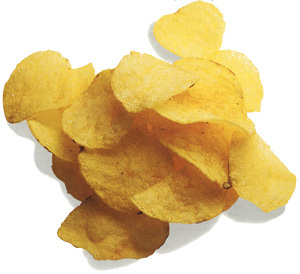Popcorn will always be my favorite snack food of choice to munch on during a movie or when watching sports on television, but when there’s no popcorn to be found, potato chips are what I go searching for next. Sure, I munch on more than my fair share of carrots sticks and broccoli, but when watching TV or a movie, munching on potato chips is just one of those things that you’re supposed to do.
Better change that to the past tense.
In case you didn’t know, acrylamide is a dangerous chemical present in foods such as French fries, potato chips, breakfast cereals, cookies and crackers. Problem is, it’s difficult to determine exactly how much of this chemical, which is a natural byproduct of cooking starchy food at high temperatures, is present in any given food.
Under intense heat that may be experienced, particularly in a high temperature oven or fryer – some elements of proteins react with natural sugars and fuse to a dark caramel brown in a process (that you may recall from chemistry class is termed the Maillard reaction). The darker the brown (or more “well-done” the protein and sugar combination becomes) the more of the chemical acrylamide is formed.
The Globalist.com (www.theglobalist.com) points out those high levels of acrylamidein food were first reported in 2002, but currently little is known about how acrylamide forms, exactly how it affects people or what to do about it.
What is known however, is that studies have shown that according to research conducted by the Office of Environmental Health Hazard Assessment, acrylamide causes cancer in lab mice and rats. The federal limit for acrylamide in drinking water is .5 parts per billion, or about .12 micrograms in an eight-ounce glass of water. However, a six-ounce serving of French fries or potato chips can contain 60 micrograms of acrylamide.
According to Bionet.com (www.bionet.com) no manufacturers provide information on how much acrylamide is present in their products, and the most recent FDA data is more than two years old.
And speaking of potato chips, when it comes to high levels acrylamide, the worst offenders — according to an independent study conduced by the California-based Environmental Law Foundation (www.envirolaw.org) are the following well known brands:
– Lay’s potato chip maker PepsiCo Inc.
– Pringles maker Proctor & Gamble Co.
– Cape Cod potato chip parent Lance Inc.
– Kettle Chips maker Kettle Foods Inc.
And these are just some of the better-known manufacturers of potato chips. Who knows how many others are out there yet to be investigated. The Environmental Law Foundation has filed notices with the state’s attorney general against these potato chip manufacturers and is arguing that these manufacturers and others would be required to place labels on their products warning consumers about the high levels of acrylamide found inside.
The Food and Drug Administration (www.fda.gov) claims it is researching the problem, but has publicly stated that it doesn’t believe “additional sampling will improve our exposure assessment significantly.” Also blurring the argument in the eyes of federal regulators: French fry samples from seven different McDonald’s restaurants yielded varying amounts of acrylamide.
The presence of acrylamide and other currently unrecognized toxins certainly present a good argument for avoiding processed foods as often as possible, and instead eating raw foods.
Experts are now recommending that the next time you get the choice, opt for the lightly cooked – or at worst the pleasantly gilded French fries or potato chips.
In the meantime, half the stuff I enjoy eating looks like it’ll kill me eventually. By default I’m going to get healthier seeing as how most of my vices are hazardous to my health.



